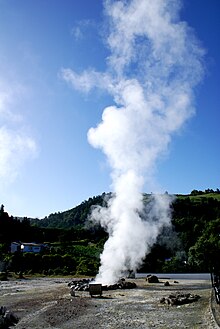Furnas (Azores)
| Furnas | ||||||
|---|---|---|---|---|---|---|
|
||||||
| Basic data | ||||||
| Autonomous Region : | Azores | |||||
| Concelho : | Povoação | |||||
| Coordinates : | 37 ° 46 ′ N , 25 ° 19 ′ W | |||||
| Residents: | 1439 (as of June 30, 2011) | |||||
| Surface: | 34.43 km² (as of January 1, 2010) | |||||
| Population density : | 42 inhabitants per km² | |||||
| Height: | 303 m | |||||
| Postal code : | 9650-xxx | |||||
Furnas is a Portuguese freguesia (roughly: municipality) in the district of Povoação on the island of São Miguel in the Azores .
Location and population
Furnas covers an area of 34.4 km² and has a population of 1,439 inhabitants (as of June 30, 2011). The population density is 41.8 inhabitants / km². The place is located at the beginning of the eastern third of São Miguel in an extensive caldera , which is surrounded on all sides with up to 760 m high wooded crater walls.
geography
Furnas is around 270 m above sea level. d. M. in the valley Vale das Furnas , which is of volcanic origin, measures about 6 km in length and 5 km in width and looks more like a hollow than a valley. The valley has its own microclimate, the humidity and mean temperature of which are above the average values of the island of São Miguel, so that the vegetation includes various species such as cedars and araucarias that otherwise could not thrive in this geographical latitude. A total of 23 warm to hot mineral springs and fumaroles called caldeiras with a water temperature of up to 98 degrees arise in the valley . The volcanic activity is mainly shown in the so-called caldeiras , steaming places of boiling water. They are the main attraction of Furnas, visible from afar. Their sulphurous water, which is not drinkable on site , is not only used to cook food, but is also used to make tea, for example.
The 176 ha large lake Lagoa das Furnas , which was created at the deepest point of the valley, is known for the numerous fumaroles and solfataras on its edge.
economy
The main sources of income are agriculture and tourism. The Terra Nostra Botanical Garden with its thermal pool is located behind the hotel of the same name and is an important tourist attraction. Other thermal pools are distributed around the village and are privately operated.
history
One of the first pieces of news from Furnas speaks of logging work after the destruction of many houses in the earthquake of October 22nd 1522 and landslides in Vila Franca do Campo . Captain Rui Gonçalves also had many trees cut down to rebuild the parish church. In 1553, Captain D. Manuel da Câmara issued a regulation on reforestation after the area was almost deforested; his son Rui Gonçalves developed the area and widened the paths, which after 1577 allowed pasture farming.
During the reign of Don Manuel da Camara, the governor of the island of São Miguel, a chapel was built in 1613 in honor of Our Lady of Consolation and a small residence for the pastor, who was in charge of worship and the daily lighting of a lamp in the sacristy. The first houses appeared in 1615 and a small monastery was built near the chapel. In 1630 there was the last volcanic eruption in the crater of Furnas with 195 fatalities. After that, the area was deserted until new settlers came back to the valley (mostly from Ponta Garça , Povoação , Vila Franca do Campo and Maia ) when the land became fertile again. New roads were built in 1682/1683 by order of Baron Larangeiras.
In 1832 an unknown English settler bought a large piece of land to build a house on the crater lake Lagoa das Furnas , but soon sold it to the Consul General in Ponta Delgada , called Viñas , in 1855. Mr. Viñas built a summer house with a garden that he named Grenå in honor of his wife's family ties.
Traditions
One of the typical gastronomic offers in Furnas is the Cozido à portuguesa , consisting mainly of vegetables, meat, sausages and rice or potatoes. The traditional method of preparation is to put the pot in a hole in the ground and let the dish cook in the volcanic heat. Another specialty of the valley is Bolo Lêvedo , a type of bread made from milk, eggs, sugar and wheat flour.
Individual evidence
- ↑ www.ine.pt - indicator resident population by place of residence and sex; Decennial in the database of the Instituto Nacional de Estatística
- ↑ Overview of code assignments from Freguesias on epp.eurostat.ec.europa.eu
- ^ Wilhelm Voss-Gerling: Madeira, Azoren , p. 51. Munich 1972
- ↑ Stéphan Szeremeta: Açores , p. 114. Paris 2014
- ^ Wilhelm Voss-Gerling: Madeira, Azoren , p. 52. Munich 1972
- ↑ Susanne Jaep: Azores 41. Ostfildern 1998
- ↑ Tommy Andersson: Geology of Lagoa das Furnas, a crater lake on São Miguel, Azores archipelago (PDF; 2.77 MB). Dissertation, Stockholm University, 2005, p. 7.
- ↑ Susanne Jaep: Azores , 40. Ostfildern 1998











